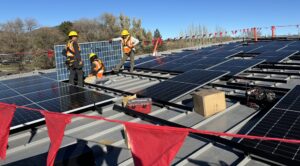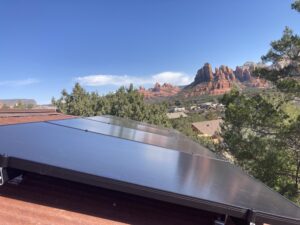NEM or Net Energy Metering is the system by which utility companies are required to pay people back for their solar. It has served as one of the most effective policies to help further the renewable energy market since 1995. It has long ensured homeowners are properly compensated for their contributions to the grid and tremendously benefited the energy grid as a whole both with SDG&E and other companies. You may have heard of SDGE net metering ending, and indeed a group of electric power companies in California has now come out against NEM, claiming that it puts undue costs on them that then get passed onto customers. They claim that they cannot absorb these costs and that they must be passed onto non-solar customers, or even specifically homeowners in lower-income areas. Read on to find out the truth about the effects of PG&E, SCE, and SDGE Net Metering on customers and how that compares to the proposed changes in California.
How Net Metering Works
Net metering allows a customer to essentially use the power grid as a giant battery. It allows solar homeowners to use the power they need now from their energy production while sending any excess out onto the grid. This is an important part of what makes solar viable for the homeowner, and historically utilities have allowed for a year-round reconciliation as opposed to a SDGE net metering cap. Caps of this type prevent solar homeowners from profiting off of solar and in many cases make it a non-viable option as they give the homeowners a set rate for their solar as opposed to valuing it at the same rate that they charge for energy. These policies are also very good for the grid since the power you don’t need now is used by your neighbors and you receive credits for this energy.
Net metering in San Diego and elsewhere emboldens the overall economy in the form of job creation, creates a smoother demand curve for electricity, and allows utilities to better manage their peak electricity loads. Net metering can also reduce the strain on distribution systems and prevent losses in transmission and distribution. All of this seems good, but there is some downside for the utility company, as they are no longer being paid as the sole provider of energy in the area. For this reason and others, there have been some changes proposed to the net metering SDGE and other companies are proposing.
Proposed Changes in California
At the moment, we probably have a couple of weeks or months before we see the final proposed changes to NEM in California, but these power companies have submitted “comments” requesting the most drastic changes possible. This all comes in a state where there has not been a tax rebate or California solar rebate for a number of years. In fact, the commonly known solar rebates in California are in fact the rate at which the utility compensates you for your power. These utility companies are calling to have payback reduced by as much as 50%-75%, in addition to multiple types of new fees.
The utilities are also calling to do away with the current ‘grandfathering’ of customers into equal payback which would perhaps have the most negative effect on the solar investment we have seen in California. This would mean that in the future if the utilities get to lower their payback more, you would not get to stay in the rate structure you signed up for. Finally, they are asking for substantially larger ‘grid-connection fees’ every month just to have solar. We have seen similar proposals from utilities in other states, including APS in Arizona, where the corporation commission gives the utility far less than they are asking for, thankfully. What solar panel rebates California offers in the future, however, remain to be seen.
Response from the Solar Industry
At the time of writing, 26,601 solar advocates have signed a petition to Gavin Newsom called Save California Solar which you can find here: https://www.savecaliforniasolar.org/sign-petition#/36/. There has also been a lot of backlash to the essential claims made by the utility companies in all of this, namely from Dave Rosenfeld of the Solar Rights Alliance who said “Half of California’s Rooftop Solar is found in working and middle-class neighborhoods.” Overall, it seems there is a legitimate disagreement as to whether net energy metering hurts non-solar customers or only the profits of monopoly utility companies.
As stated, it seems unlikely that these utilities will get exactly what they’re asking for, and this is a big moment for California solar and an opportunity to further clean energy and savings for the homeowner if the California Public Utilities Commission and Governor Gavin Newsom choose to make it so. The future of net energy metering and any California solar energy credit is important not only for California but for the country as a whole as we often set the standard for solar policy. In the meantime, a Rooftop Solar specialist can reach out with a quote today before these changes come in, making this a very important time to take a look at the numbers.
https://www.seia.org/initiatives/net-metering


